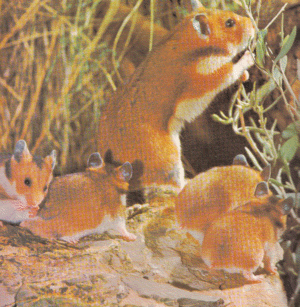 Hamsters HamstersThe
golden hamster with which most people are
familiar as a cute little pet is but one of about
14 species of hamsters, all of which are found in
the wild. Although there are literally thousands
(if not tens of thousands) of golden hamsters
kept as pets around the world, they are all
descended from a single family of one female and
12 young that were dug up near Aleppo, Syria, in
1930.
Descriptions and
Distributions
The largest hamster is the
common (or black-bellied) hamster, which is about
the size of a guinea pig. It is light brown
above, black below, with white patches on the
sides. It is found in a broad belt from Belgium
to Lake Baikal in Siberia.
The smallest hamster is the
dwarf hamster of Siberia, Manchuria and northern
China. The head and body length is 2 to 4 inches
and the tail is short. The upperparts are grayish
or buff and the underparts white.
Between those two extremes are
the seven species of gray hamsters, which are
from 3 to 8 inches in length with tails up to 4
inches long. The fur is usually grayish in color
but may be reddish, with white underparts. Gray
hamsters range from Greece and Bulgaria in the
Altai range on the borders of Mongolia.
The golden hamster is a light
reddish brown above and white underneath. The
tail is very short and the skin on the body
loose. In the wild it ranges from the Caucasus
and Asia Minor to Iran.
Habitats
Most hamsters usually live in
dry places, on steppes, among sand dunes and on
the borders of deserts, although the common
hamster may also found in cultivated country,
among crops or in plowed fields. It is also lives
along river banks and often swims, inflating its
cheek pouches to provide extra bouyancy. Golden
hamsters, however, cannot take moisture and may
even die if exposed to damp conditions.
Habits and Behaviors
Common and golden hamsters are
nocturnal, but will occasionally come out during
the day. In the spring and summer gray hamsters
can be seen both by day and night, but they
become completely nocturnal in the winter. When
not active, hamsters can be found in underground
burrows. Common, golden and gray hamsters have
short shallow burrows for summer use and deeper
ones for winter. The burrows are quite extensive
with several entrances and several compartments
for nesting, storing food and for latrines. Dwarf
hamsters frequently share burrows with pikas,
small relatives of rabbits and hares.
Diets
All hamsters are primarily
vegetarian, with a majority of their diet coming
from cereals; many kinds of fruits, roots, green
leaves and other plant materials are also eaten.
The common hamster will also eat frogs and insect
larvae. A wild hamster will gather food out in
the open, stuff it into its cheek pouches, and
carry it back to its burrow to be eaten. And, as
anyone who has ever had a pet hamster knows, an
incredible amount of food can be stuffed into
those pouches. One gray hamster in the wild was
seen stuffing 42 soybeans into its pouches until
its head was about 1/3 of the size of its body.
The winter food stores can also be quite large,
100 pounds of seeds and potatoes being recorded
from the burrow of a common hamster.
Reproduction
All species of hamsters are
solitary, with males and females only coming
together for mating. In captivity, golden
hamsters have to be separated after mating or the
female is likely to kill the male. In the wild,
male gray hamsters visit the burrows of females
and stay for about 10 days. The gestation period
ranges from about 15 to 20 days. The 6-12 young
are born naked and helpless but leave their
mother immediately after being weaned, at about 3
to 4 weeks of age. A female may have up to 3
litters per year.
Scientific
Classification
Phylum Chordata
Subphylum Vertebrata
Class
Mammalia
Order
Rodentia
Family Cricetidae
Genera and Species
Cricetus cricetus common hamster
Cricetulus triton gray hamster
Mesocricetus auratus golden hamster
Phodopus sungorus dwarf hamster
Questions or comments about
this page?
|



